Updated analysis of the archival OGLE-II lightcurve of the possible progenitor of MASTER OT J051032.58-692130.4
Thanks to the comments by Dr. Udalski following the publication of ATel #9048, it was discovered that the OGLE-II DIA lightcurve of LMC_SC10.20872 has a lower scatter compared to the originally analyzed OGLE-II PSF lightcurve. The DFT periodogram of the DIA lightcurve reveals the peak reported at ATel #9040 confirming identification of the OGLE-II object LMC_SC10.20872 with the OGLE-IV candidate progenitor.
Shuffling the JD-mag pairs in a lightcurve and computing a fraction of the simulated lightcurves having a periodogram peak at least as high as the original lightcurve gives a lower limit on the chance occurrence of the periodogram peak. The shuffling destroys correlated noise that might be present in the data keeping only the random errors (hence the lower limit). For the OGLE-II DIA lightcurve of LMC_SC10.20872 in the period range 10-1.0 days the resulting fraction is 0.0021, and for the period range 10-0.1 days - 0.0187. This may be considered a significant detection of a periodic variation, assuming the correlated noise contribution is negligible.
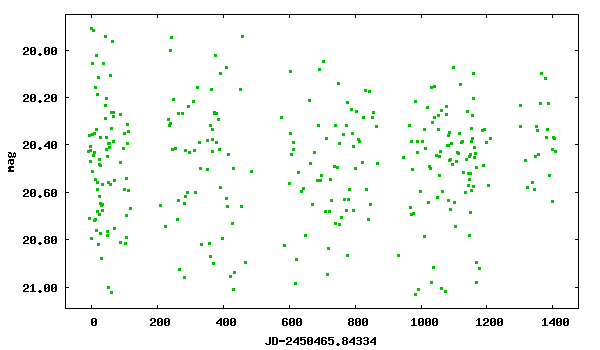
The OGLE-II DIA lightcurve of LMC_SC10.20872.
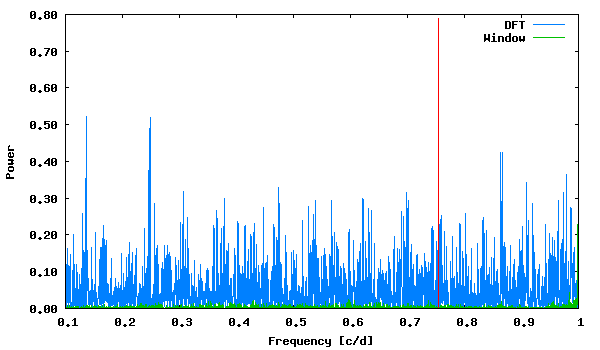
Deeming (1975) Discrete Fourier Transform (DFT) of the OGLE-II DIA lightcurve of LMC_SC10.20872.
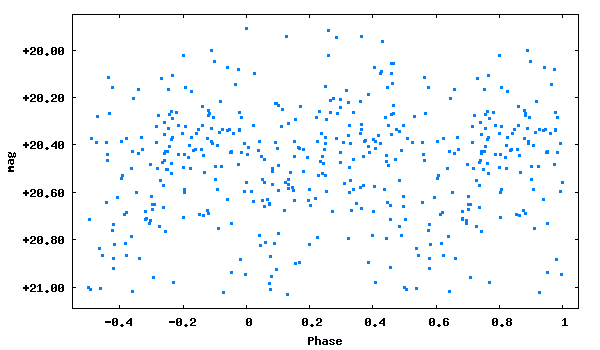
The DIA lightcurve of LMC_SC10.20872 phased with a period of 2.6513489 d corresponding to the half-frequency (two waves per period) of the DFT peak marked in red at the above plot.
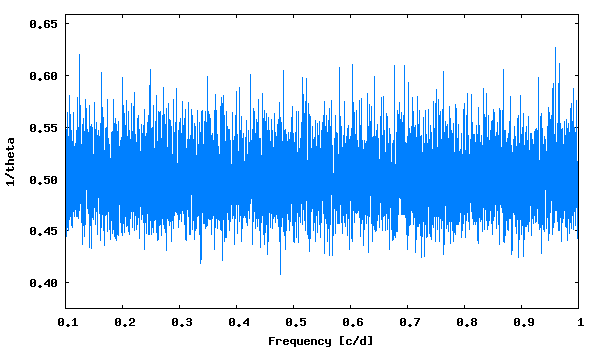
Lafler & Kinman (1965) periodogram of the LMC_SC10.20872 OGLE-II DIA lightcurve still reveals on sigificant peaks.
Swift observation of the LMC nova candidate MASTER OT J051032.58-692130.4
Kirill Sokolovsky (IAASARS NOA/SAI MSU/ASC Lebedev)The optical transient MASTER OT J051032.58-692130.4 was discovered by MASTER-SAAO on 2016-05-10.72797 (ATel #9039). Pre-discovery images by OGLE-IV indicate that the outburst occurred some time between 2016-04-21.00403 and 28.97626 (ATel #9040). The object was observed by Swift for 2ks starting on 2016-05-12.07560 UT.
The transient is clearly visible in Swift/UVOT images at the position 05:10:32.58 -69:21:30.5 +/-0.1" J2000 measured with respect to UCAC4 stars within the UVOT field of view. The object's observed Vega magnitudes in three ultraviolet bands are white
JD(TT)2457520.59876 W1 11.52 +/-0.02 JD(TT)2457520.59166 M2 11.68 +/-0.02 JD(TT)2457520.58271 W2 11.76 +/-0.02corresponding to a T~10^4 K black body after correcting for the Galactic extinction.
No X-ray source is detected by Swift/XRT at the position of the optical/ultraviolet transient above the background level of 2.6e-03 cts/s. Assuming kT=5 keV thermal bremsstrahlung emission and absorption with HI column density of 2e21 cm^-2, this corresponds to a 0.3-10 keV flux limit of 1.2e-13 ergs/cm^2/s.
The intriguing feature of the transient is its suggested OGLE-IV progenitor reportedly showing a 2.65 d eclipse-like periodicity (ATel #9040). Such period is unusually long for a classical nova system and makes one suspect a nova in a symbiotic binary or even a V1309 Sco-like stellar merger event. An object LMC_SC10.20872 offset by 0.4" from the reported OGLE-IV position and 0.6" from the UVOT position is present in the public OGLE-II photometric database, however a period search reveals no obvious periodicity in the OGLE-II lightcurve. The relation between the OGLE-II and OGLE-IV objects is unclear as this is a very crowded field. Apart from the suggested eclipsing binary progenitor, observed properties of the transient so far are consistent with a classical nova outburst.
We thank Neil Gehrels and the Swift team for rapid approval and scheduling of this ToO observation.
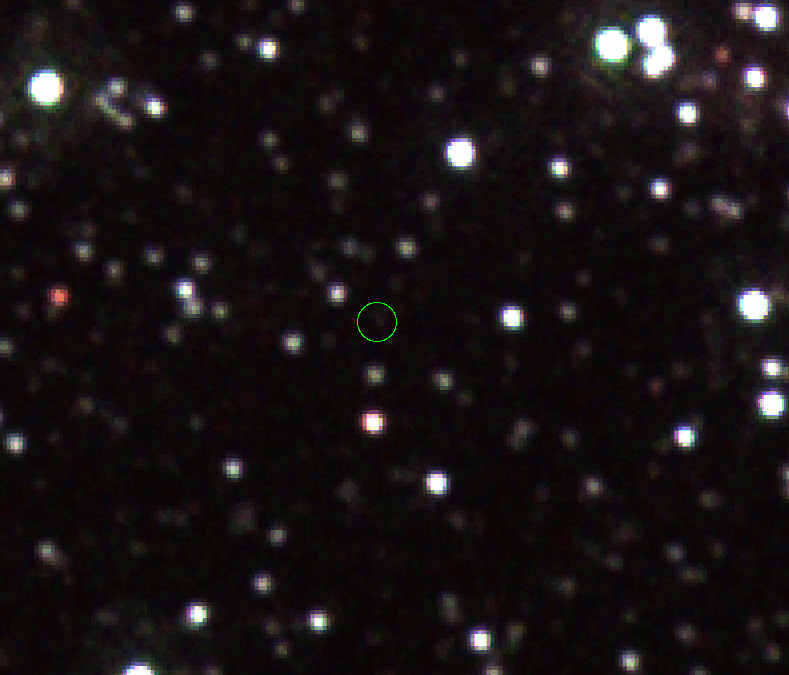 Animation of Swift/UVOT ultraviolet images obtained on 2013-01-03
(obsid:00045471002) and 2016-05-12 (obsid:00045471003).
The red, green, and blue colors represent W1, M2, and W2 filters, respectively.
The field of view is ~3', North is up, East is to the left. The green circle is 5" in
diameter and centered on the position of the transient.
Animation of Swift/UVOT ultraviolet images obtained on 2013-01-03
(obsid:00045471002) and 2016-05-12 (obsid:00045471003).
The red, green, and blue colors represent W1, M2, and W2 filters, respectively.
The field of view is ~3', North is up, East is to the left. The green circle is 5" in
diameter and centered on the position of the transient.
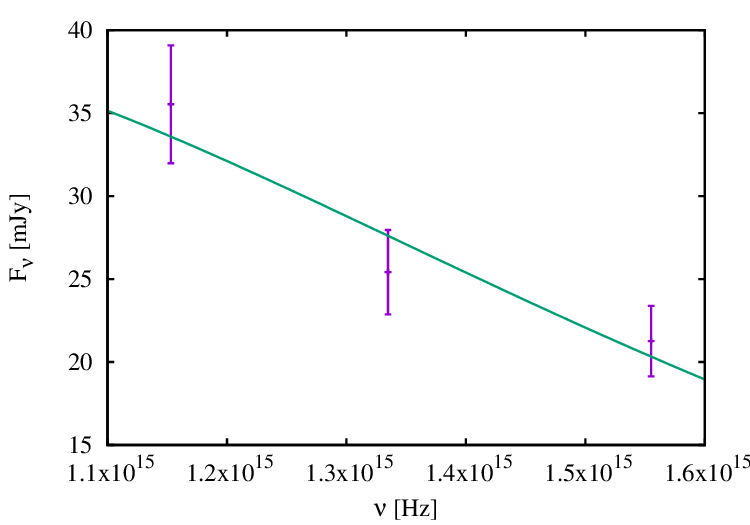 Swift/UVOT ultraviolet photometry of MASTER OT J051032.58-692130.4 obtained on 2016-05-12
compared to the black-body spectrum with T=14000 K. The errorbars represent the expected
10% uncertainty of flux density calibration and extinction correction.
Swift/UVOT ultraviolet photometry of MASTER OT J051032.58-692130.4 obtained on 2016-05-12
compared to the black-body spectrum with T=14000 K. The errorbars represent the expected
10% uncertainty of flux density calibration and extinction correction.
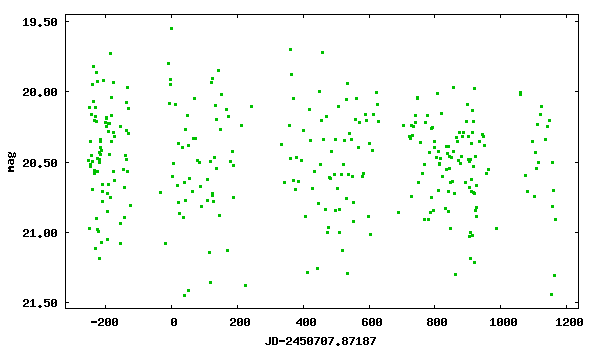
The OGLE-II PSF lightcurve of LMC_SC10.20872.

Lafler & Kinman (1965) periodogram of the LMC_SC10.20872 OGLE-II PSF lightcurve.
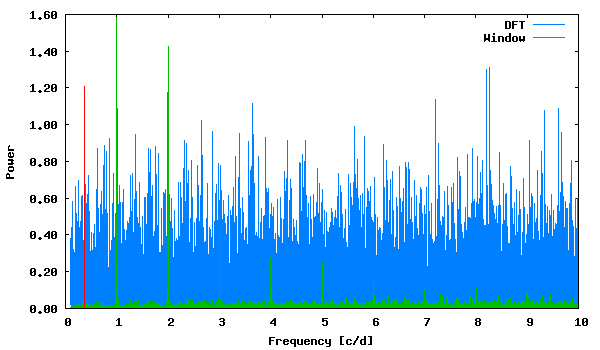
Deeming (1975) Discrete Fourier Transform (DFT) of the OGLE-II PSF lightcurve of LMC_SC10.20872.
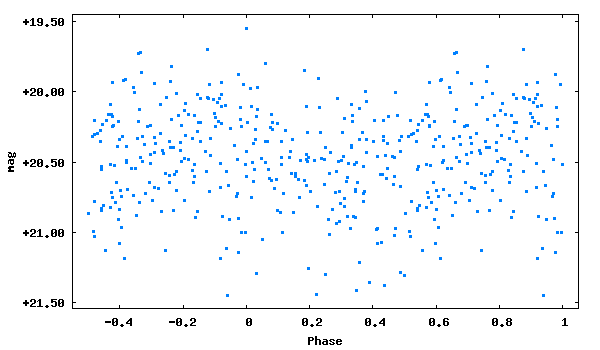
The PSF lightcurve of LMC_SC10.20872 phased with a period of 2.7370714 d corresponding to the DFT peak marked in red at the above plot. The period is likely to be spurious and this plot is provided here as an illustration of a phased lightcurve corresponding to one of the DFT peaks. The peaks at 1 and 2 cycles per day correspond to the long-term declining trend in the lightcurve (possibly of instrumental origin).